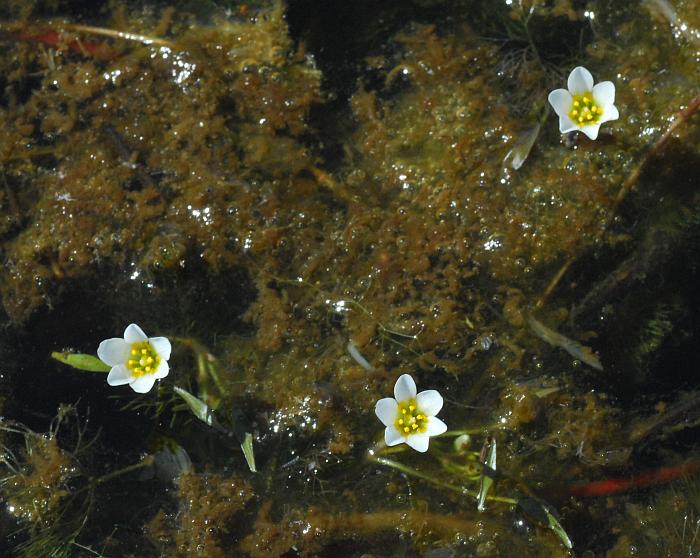Cabomba caroliniana A. Gray
Carolina Water Shield

Native
CC = 8
CW = -5
MOC = 13
© SRTurner
Cabomba caroliniana A. GrayCarolina Water Shield | |
 |
Native CC = 8 CW = -5 MOC = 13 |
© SRTurner |
|
Family - Cabombaceae Habit - Perennial, emergent aquatic forb.
Stem - Mostly submerged, inconspicuously hairy when young.
Leaves - Strongly dimorphic, with emergent leaves only present at flowering. Submerged leaves opposite, petiolate, to 4 cm long and broad, fan-shaped, palmately divided into 5-7 parts, each of these further divided into narrow, threadlike segments. Emergent leaves alternate, long-petiolate, peltate, with blades to 2 cm long, entire, roughly oblong but often shallowly notched.
Inflorescences - Solitary flowers in leaf axils, on relatively long stalks which position the flowers just above the water surface. Stalks later bending to become submerged as the fruits develop.
Flowers - Sepals 3, 5-10 mm long, petaloid, elliptic to obovate, white. Petals 3, 5-10 mm long, elliptic to obovate, sagittate toward the base and thus appearing short-stalked, white with the basal auricles each with a yellow nectary. Stamens 6. Pistils 2-4, the stigma capitate.
Fruits - Achenelike, 4-7 mm long, narrowly ovoid to somewhat peanut-shaped, tapered to the persistent style. Seeds 1.5-3.0 mm long, oblong-ovate in outline, the surface finely pebbled, with 4 longitudinal rows of dense tubercles visible when moistened, greenish brown to brown. Flowering - May - September. Habitat - Submerged aquatic in ponds, sloughs, swamps, ditches. Origin - Native to the U.S. Lookalikes - Vegetatively, Ceratophyllum spp., Ranunculus aquatilis Other info. - This attractive but easily overlooked aquatic species can produce large numbers of small white flowers at the surface of still waters, while most of the plant remains submerged. The plant is easily identified by its flowers and the dimorphic leaves. The sepals and petals are similar, collectively forming a six parted perianth. The plant is not common in Missouri, with most collections coming from the Bootheel area. Its U.S. distribution is mainly southeastern. The plant's foliage could be confused with species of Ceratophyllum or Ranunculus aquatilis, which also have dissected, fan-shaped leaves. However, the leaf arrangement on these latter species is alternate. Photographs taken at Duck Creek Conservation Area, 8-26-2015 and 8-17-2021 (SRTurner). |